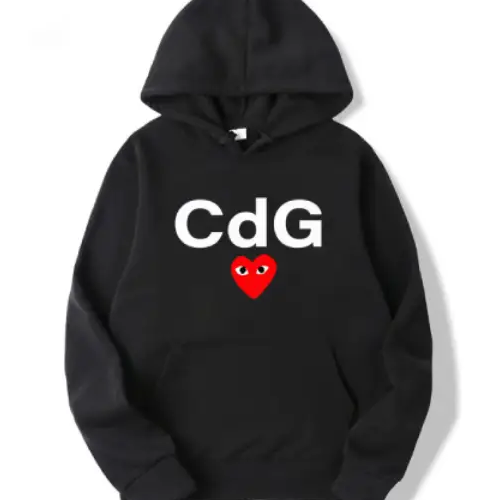The Avant-Garde World of Comme des Garçons
Comme des Garçons, often abbreviated as CDG, is a globally celebrated fashion brand that has revolutionized the industry with its avant-garde designs and non-conformist philosophy. Established in 1969 by Japanese designer Rei Kawakubo, the brand’s name, which translates to “Like Boys” in French, hints at its gender-defying ethos and bold approach to fashion. Today, Comme des Garçons stands as a cultural icon, revered for pushing boundaries and redefining the very concept of style.
Origins and Philosophy
Rei Kawakubo, a self-taught designer with a background in fine arts and literature, founded Comme des Garçons in Tokyo. The brand’s early designs were characterized by their monochromatic palettes, asymmetry, and deconstruction—a stark contrast to the bright and polished aesthetics dominating fashion at the time. Kawakubo’s philosophy was rooted in challenging conventional beauty standards, prioritizing form, texture, and structure over traditional notions of femininity or masculinity.
In 1981, Comme des Garçons made its Paris debut, where Kawakubo’s collection, dubbed “Hiroshima Chic,” shocked audiences with its distressed fabrics, loose silhouettes, and unconventional cuts. This bold introduction established the brand as a disruptor in the fashion world and marked the beginning of its global influence.
Aesthetic and Innovation
Comme des Garçons is synonymous with experimental design. Its collections often blur the lines between fashion and art, featuring sculptural silhouettes, unexpected fabric combinations, and conceptual themes. Kawakubo’s approach to fashion is deeply intellectual, with each collection telling a story or exploring an abstract idea. From garments that mimic body armor to pieces that challenge traditional tailoring, Comme des Garçons continuously redefines what clothing can represent.
The brand’s aesthetic is also heavily influenced by Japanese culture and traditions, often integrating elements of wabi-sabi—the beauty of imperfection—into its designs. This philosophy is evident in the brand’s use of raw edges, irregular stitching, and distressed textures, which give its pieces a unique, handcrafted quality.
Sub-Labels and Collaborations
Comme des Garçons is not just a singular brand but a fashion empire with multiple sub-labels catering to diverse audiences. These include:
- Comme des Garçons Homme: A menswear line that offers a blend of classic tailoring and experimental design.
- Comme des Garçons Play: A casual, youth-oriented line featuring the iconic heart logo designed by Polish artist Filip Pagowski.
- Comme des Garçons Noir: A label dedicated to Kawakubo’s signature monochromatic and textural designs.
- Comme des Garçons Shirt: A playful take on traditional shirting with bold prints and unconventional cuts.
The brand has also collaborated with numerous global entities, including Nike, Converse, Supreme, and Louis Vuitton. These partnerships have brought Comme des Garçons’ avant-garde ethos to a wider audience while maintaining its distinctive identity.
Retail Experience
Comme des Garçons is known for its innovative retail spaces, which reflect the brand’s artistic vision. From the minimalist, industrial interiors of its flagship stores to the immersive environments of its pop-up installations, each space is designed to challenge conventional retail norms. The brand’s Dover Street Market, a multi-brand concept store founded by Kawakubo and her husband Adrian Joffe, has become a global destination for fashion enthusiasts, showcasing cutting-edge designers alongside Comme des Garçons’ own collections.
Influence and Legacy
Over the decades, Comme des Garçons has left an indelible mark on the fashion industry. Rei Kawakubo’s groundbreaking designs have inspired generations of designers, from Alexander McQueen to Yohji Yamamoto. The brand’s emphasis on creativity over commercialism has also paved the way for other avant-garde labels to thrive.
In 2017, the Metropolitan Museum of Art’s Costume Institute honored Kawakubo with a retrospective exhibition titled “Rei Kawakubo/Comme des Garçons: Art of the In-Between.” This rare recognition, previously bestowed only upon Yves Saint Laurent, solidified Kawakubo’s status as one of the most influential designers of our time.
Sustainability and the Future
Comme des Garçons has begun to address sustainability in its production practices, reflecting a growing awareness of environmental issues within the fashion industry. While the brand remains committed to its artistic vision, it is also exploring ways to reduce waste and promote ethical manufacturing.
Looking ahead, Comme des Garçons continues to challenge norms and push creative boundaries. With Rei Kawakubo at the helm, the brand remains a beacon of innovation, proving that fashion is not just about clothing but a powerful medium for self-expression and cultural commentary.
Conclusion
Comme des Garçons is more than a clothing brand; it is a movement that defies convention and celebrates individuality. Through its groundbreaking designs, conceptual collections, and unwavering commitment to creativity, CDG has redefined the fashion landscape and inspired a global community of thinkers, dreamers, and innovators. In a world often constrained by trends and commercial pressures, Comme des Garçons stands as a testament to the transformative power of art and imagination.




